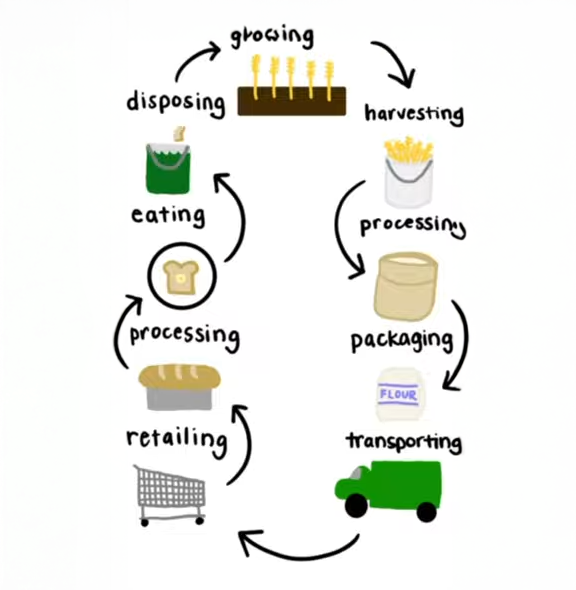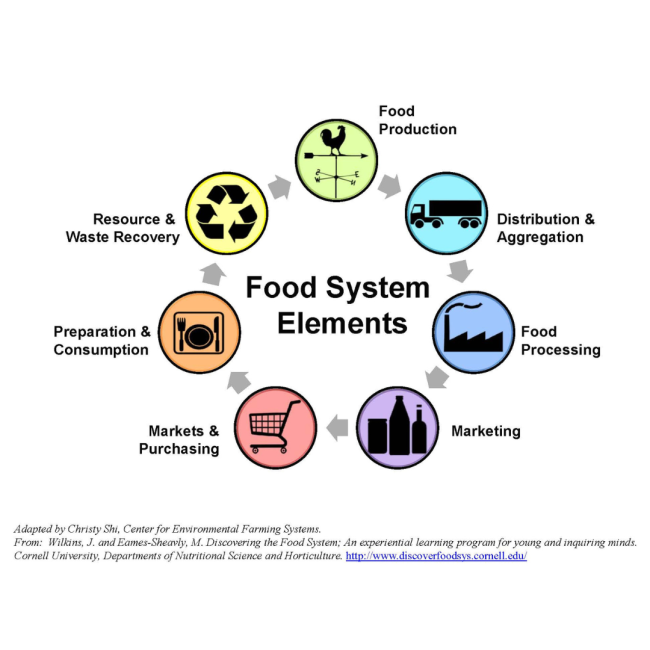Home » Community Food Systems » Dane County Food Action Plan » Dane County Food Action Plan Sectors » Infrastructure Sector
Infrastructure Sector

Food System Infrastructure Investments
Key Updates – July 31, 2025
Getting food from the producer to your plate can be a massive endeavor involving multiple steps and including a variety of different business entities. Growing or foraging your own food cuts down on the number of steps and entities involved, but you’ll still probably need a refrigerator/freezer, food processing equipment, and utensils such as running water, knives, peelers, etc., a stove or oven, and a way to handle food scraps.
But typically food will pass through many hands and vehicles before you’re able to eat it. From on-farm grading, washing and packaging to transporting either to an aggregation, processing, storage, distribution or retail facility – or maybe ALL of those! – it’s a long journey from where the food was grown to where you eat it. As the supply chain lengthens, the environmental cost increases and the portion of the purchase price going to the producer decreases. Building regional and local food supply chains is good for everyone!

In her paper, Identifying Critical Thresholds for Resilient Regional Food Flows: A Case Study From the U.S. Upper Midwest, Michelle Miller of UW–Madison’s Center for Integrated Agricultural Studies identifies challenges and gaps in our regional food system here in the Upper Midwest. While there are several local and regional food supply chains in the region that are focused on getting fresh food into both smaller urban and rural communities, there are serious barriers for Wisconsin producers to access larger markets in the Chicago and Twin Cities areas. High transportation costs due to traffic congestion, the lack of strategically-located flexible storage and distribution facilities, and the concentration of the grocery industry into big box stores located on the outskirts of communities are challenges that inhibit the growth of a greater diversity of regional supply chains.
Miller calls for public investment in the critical infrastructure that would support the creation of better organized and more efficient flows of local food:
It is in the public interest to create an ecosystem where private sector entrepreneurs may respond to opportunities in their communities to concurrently optimize fuel use, food access, and sustainable farming practices. First mile, regional, and last-mile transportation businesses; product aggregation intended for regional wholesale markets; and regional supply chain aggregation in mega-regions are just a few opportunities for small business development in the food processing, distribution, and retailing sectors.
Miller M (2021) Identifying Critical Thresholds for Resilient Regional Food Flows: A Case Study From the U.S. Upper Midwest. Front. Sustain. Food Syst. 5:684159. doi: 10.3389/fsufs.2021.684159
At the beginning of this year, the Wisconsin Department of Agriculture, Trade, and Consumer Protection (DATCP) announced the US Department of Agriculture’s (USDA) grant of $23.2 million for 30 projects in Wisconsin through the Resilient Food Systems Infrastructure (RFSI) program. The purpose of the program is, “…to build resilience in the middle of the food supply chain, to provide more and better markets to small farms and food businesses, to support the development of value-added products for consumers, fair prices, fair wages, and new and safe job opportunities.”
Demand far outstripped availability of funds for this program, with about $260 million in grant requests. None of the funded projects have a statewide, multiproduct impact, although the Wisconsin Food Hub Cooperative project for a “Super Transportation Coop” includes several distribution and aggregation partners.
5 of the 30 projects receiving grants are located in Dane County:
- Brix Cider: “Strategic Investments to Grow Brix Cider: Adding a Distillery, Essential Equipment, and Facility Improvements”
- Community Action Coalition of South Central Wisconsin: “Foodshed Partnership: An Equity-Driven Cold Storage, Produce Processing and Food Production Facility”
- Garden to Be: “Bridging Grower Opportunity and Consumer Demand for Local Produce”
- Linda and Gene Farley Center for Peace, Justice and Sustainability: “Increasing Processing and Cold Storage Capacity for Underserved, Beginning and Veteran Farmers in Dane County”
- Vitruvian Farms: “Expanding processing, aggregation, and distribution of local vegetables and fruit at Vitruvian Farms”
This is a good start, but far more investment as well as greater coordination in and among supply chains is needed to create more equitable, affordable, and sustainable food systems in our region.




